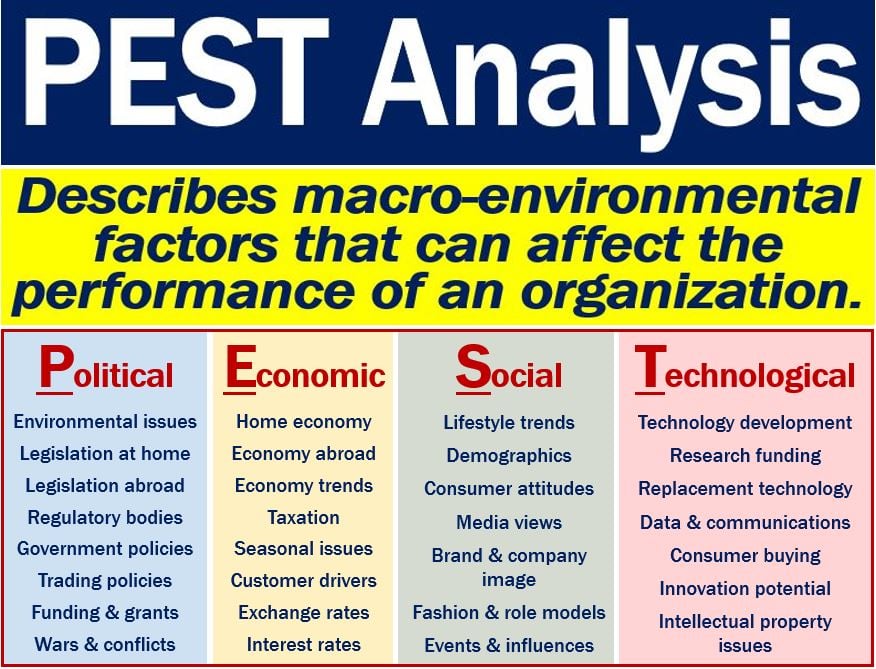A PEST Analysis is a study that helps an organization identify opportunities and threats of the external macro environment. The macro environment refers to uncontrollable external factors that affect a company. PEST is an acronym for Political, Economic, Social and Technological. They are four factors that can affect a company’s current and future performance.
A PEST Analysis can help an organization create a long-term strategy by keeping track of the external factors. It may also help determine how these factors may affect a business’ performance and growth.
Useful for many types of companies
This tool is extremely useful for global businesses and those that want to expand overseas. It is useful because it shows us what changes are occurring in the business environment.
Additionally, it can help you decide whether to initiate or abandon a new project. Specifically, projects that are vulnerable to factors over which you have no control.

The PEST analysis can help you make a decision on how profitable a country, region, and area can be for your business. All data gathered through this tool focuses on what the business needs to do to get ahead.
When making commercial and strategic decisions, we need objective analyses, forecasts, and data. The Pest Analysis is completely objective.
How to do a PEST Analysis
Before using the PEST tool, it is important to understand all the factors. You can then brainstorm each one.
Some factors are opportunities for the companies. Others, on the other hand, are potential threats. All of them are relevant. However, you should focus on the ones that affect your business the most.
You should then attribute either opportunities or threats in detail to each factor.
The factors that we attribute threats and opportunities to are:
Political factors
Political factors help determine to what extent government regulations and laws are influencing the business environment or marketplace.
Trade regulations, political stability, and employment laws are also important.
Economic factors
Economic factors let senior management know which economic issues are affecting the business. They also tell them which ones are likely to have a long-term impact.
GDP growth, inflation, interest rates, and unemployment, for example, are important factors. GDP stands for Gross Domestic Product. Foreign exchange rates and businesses cycles also affect business performance.
Social factors
With the PEST Analysis, a company can analyze socio-cultural factors and determine what’s best for its target market. It also helps the company determine what is best for consumer needs.
Demographics, cultural trends, and education are some factors. So are lifestyle, age distribution, and population.
Demography is the study of human populations and which factors make them change, such as migration, births, and deaths. Demographics are statistical data relating to human populations and groups within those populations.
Technological factors
With these factors, senior management can assess how technological advances may affect the company. They can also help determine a whole industry’s prospects.
New technologies, the technology cycle, and spending are important factors to consider. So are technology awareness and the Internet.
PEST Analysis – different types
There are several different types of PEST Analyses. Choose which is most relevant to your company.
- PESTLE or PESTEL: Political, Economic, Social, Technological, Legal, and Environmental.
- SLEPT: Social, Legal, Economic, Political, and Technological.
- STEPE: Social, Technological, Economic, Political, and Ecological.
- STEEPLE: Social, Technological, Economic, Environmental, Political, Legal, and Ethical.
- PESTLIED: Political, Economic, Social, Technological, Legal, International, Environmental, and Demographic.
Performing analyses simultaneously
Business professionals often carry out different types of analyses simultaneously. They may perform a SWOT Analysis alongside a PEST Analysis.
A SWOT Analysis is a diagram that helps organizations identify key weaknesses, strengths, opportunities, and threats.
With SWOT Analyses, companies can create new strategies to position themselves better in the marketplace. We also refer to it as a SWOT Matrix.
